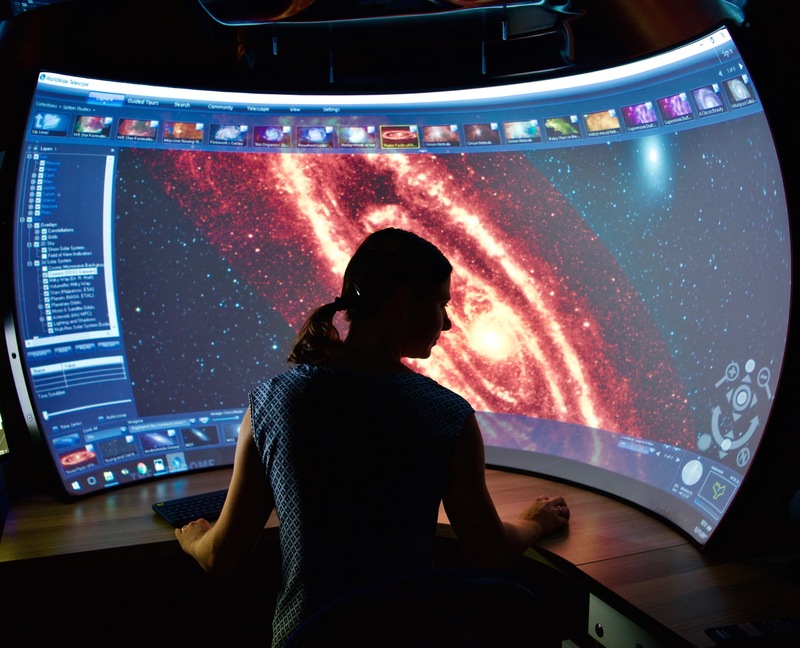A new laboratory for visualising the universe
11 March 2018 | Story Shabnam Parker Photo Thomas Jarrett and Stéphane Courteau Read time 4 min.
The Inter-University Institute for Data Intensive Astronomy (IDIA) has launched a new visualisation facility at the University of Cape Town: a shared space where astronomers from around the country can explore their data – and find answers to some of the biggest questions about our universe.
This is particularly relevant ahead of the development of the Square Kilometre Array (SKA) – an international effort to build the world’s largest and most sensitive radio telescope in South Africa and Australia. This project, which will generate data at an unprecedented rate, signals a new frontier in data-intensive research.
The SKA will create data at a pace faster than current global internet traffic, which means these datasets cannot be analysed on a normal desktop computer. To cope with the challenges presented by the SKA and its precursor projects, such as the MeerKAT array in the Northern Cape, scientists need new ways to engage with these large volumes of data.
The tools researchers previously used to work with their datasets, no longer meet the needs of big-data science.
IDIA is at the forefront of building the capacity and expertise to enable data-intensive research. The IDIA Visualisation Laboratory, launched in February, gives astronomers the ability to find patterns in their data by viewing it visually.
Professor Russ Taylor, director of IDIA and the SKA Research Chair in Radio Astronomy at the University of Cape Town and the University of the Western Cape, contends that visualisation presents one of the biggest challenges in this era of big-data astronomy. “We have these really big datasets which are very rich and very large, and different in character to the kinds of datasets we have traditionally been working with.”
But how do we mine, observe and analyse these new kinds of datasets?
“Researchers don’t want to look at little bits of big data,” emphasises Taylor. “We want to look at as much of the data as we can and at a full resolution to get the big picture.”
To facilitate this kind of large-scale analysis, the new visualisation laboratory boasts three innovative devices:
- a grid of four television screens, affectionately known as WALIE – the Wide Area Large Interactive Explorer – that allows researchers to look at large datasets in high definition;
- a curved 1.8-metre panorama display in which a researcher can sit and experience their data in an interactive environment; and
- a virtual reality platform enabling researchers to become one with the data in a three-dimensional space.
These technologies support the purpose of the laboratory, which has two parts. The one is to facilitate developers and researchers working together to develop the technology to support big-data research, and provide a platform to test, experiment and build new software systems. This will be particularly important when the MeerKAT array expands to its full scale of operations this year.
The goal is for developers and information technologists to work with research teams so that each field informs the other, and results in an effective strategy for processing – in South Africa, rather than abroad – the data from the MeerKAT and SKA telescopes.
The other purpose of the new visualisation laboratory is to provide a facility for IDIA researchers from the University of Cape Town, the University of Western Cape, North-West University and the University of Pretoria to work with and experience their data in an immersive environment. By viewing their data in this way, researchers will be able to explore, identify and examine patterns in the universe.
This will allow them to answer fundamental questions that the SKA project seeks to understand: What is the nature of reality? How did the universe – and the stars and galaxies within it – form and evolve? Can we map a complete history of time? Are we alone?
This will ultimately change our understanding of the universe and help to illuminate the unknown.
 This work is licensed under a Creative Commons Attribution-NoDerivatives 4.0 International License.
This work is licensed under a Creative Commons Attribution-NoDerivatives 4.0 International License.
Please view the republishing articles page for more information.
Research & innovation





































